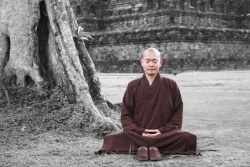Difference between revisions of "Buddhavacana"
(Created page with "thumb|250px| Buddhavacana, from Pali and Sanskrit, means "the Word of the Buddha." It refers to the works accepted within a tradition as being the teaching...") |
|||
| Line 1: | Line 1: | ||
[[File:Guojun.jpg|thumb|250px|]] | [[File:Guojun.jpg|thumb|250px|]] | ||
| − | Buddhavacana, from Pali and Sanskrit, means "the Word of | + | Buddhavacana, from [[Pali]] and [[Sanskrit]], means "the Word of [[The Buddha]]." It refers to the works accepted within a tradition as being the teachings of [[The Buddha]]. All traditions recognize certain texts as buddhavacana which make no claim to being the actual words of [[THE historical Buddha]], such as the Theragāthā and Vimalakīrti Nirdeśa [[Sūtra]]. |
| − | In early Buddhism | + | In early [[Buddhism]] |
| − | According to Donald Lopez, criteria for determining what should be considered buddhavacana was developed at an early stage, and that the early formulations do not suggest that | + | According to Donald Lopez, criteria for determining what should be considered buddhavacana was developed at an early stage, and that the early formulations do not suggest that [[THE DHARMA]] is limited to what was spoken by [[THE historical Buddha]]. The Mahāsāṃghika and the Mūlasarvāstivāda considered both [[The Buddha]]'s discourses, as well those of [[The Buddha]]'s disciples, to be buddhavacana. |
| − | A number of different beings such as | + | A number of different beings such as [[Buddhas]], disciples of [[The Buddha]], ṛṣis, and devas were considered capable to transmitting buddhavacana. The content of such a discourse was then to be collated with the sūtras, compared with the [[Vinaya]], and evaluated against the nature of [[THE DHARMA]] These texts may then be certified as true buddhavacana by a [[Buddha]], a [[Saṃgha]], a small group of elders, or one knowledgeable elder. |
| − | In Theravada Buddhism | + | In [[Theravada]] [[Buddhism]] |
[[File:Janismartin.jpg|thumb|250px|]] | [[File:Janismartin.jpg|thumb|250px|]] | ||
| − | In Theravada Buddhism, the standard collection of buddhavacana is the Pali Canon. The oral tradition of the Theravadin recension of Buddhist texts dates back to the time of | + | In [[Theravada]] [[Buddhism]], the standard collection of buddhavacana is the [[Pali]] Canon. The oral tradition of the [[Theravadin]] recension of [[Buddhist texts]] dates back to the time of [[The Buddha]] and was arranged in its current form 80 BC. |
| − | In East Asian Buddhism | + | In East Asian [[Buddhism]] |
| − | In East Asian Buddhism, what is considered buddhavacana is collected in | + | In East Asian [[Buddhism]], what is considered buddhavacana is collected in [[The Chinese Buddhist Canon]]. The most common edition of this is the Taishō [[Tripiṭaka]]. |
| − | According to Venerable Hsuan Hua from the tradition of Chinese Buddhism, there are five types of beings who may speak the sutras of Buddhism: a | + | According to [[Venerable]] [[Hsuan Hua]] from the tradition of [[Chinese Buddhism]], there are five types of beings who may speak the sutras of [[Buddhism]]: a [[Buddha]], a disciple of a [[Buddha]], a [[Deva]], a ṛṣi, or an emanation of one of these beings; however, they must first receive certification from a [[Buddha]] that its contents are true [[Dharma]]. Then these sutras may be properly regarded as buddhavacana. |
| − | In Tibetan Buddhism | + | In [[Tibetan Buddhism]] |
| − | In Tibetan Buddhism, what is considered buddhavacana is collected in the Kangyur. The East Asian and Tibetan Buddhist canons always combined Buddhavacana with other literature in their standard collected editions. However, the general view of what is and is not buddhavacana is broadly similar between East Asian Buddhism and Tibetan Buddhism. | + | In [[Tibetan Buddhism]], what is considered buddhavacana is collected in the Kangyur. The East Asian and [[Tibetan Buddhist]] canons always combined Buddhavacana with other literature in their standard collected editions. However, the general view of what is and is not buddhavacana is broadly similar between East Asian [[Buddhism]] and [[Tibetan Buddhism]]. |
{{W}} | {{W}} | ||
[[Category:Buddhist Texts]] | [[Category:Buddhist Texts]] | ||
[[Category:Buddhist Terms]] | [[Category:Buddhist Terms]] | ||
Revision as of 22:16, 27 March 2013
Buddhavacana, from Pali and Sanskrit, means "the Word of The Buddha." It refers to the works accepted within a tradition as being the teachings of The Buddha. All traditions recognize certain texts as buddhavacana which make no claim to being the actual words of THE historical Buddha, such as the Theragāthā and Vimalakīrti Nirdeśa Sūtra.
In early Buddhism
According to Donald Lopez, criteria for determining what should be considered buddhavacana was developed at an early stage, and that the early formulations do not suggest that THE DHARMA is limited to what was spoken by THE historical Buddha. The Mahāsāṃghika and the Mūlasarvāstivāda considered both The Buddha's discourses, as well those of The Buddha's disciples, to be buddhavacana.
A number of different beings such as Buddhas, disciples of The Buddha, ṛṣis, and devas were considered capable to transmitting buddhavacana. The content of such a discourse was then to be collated with the sūtras, compared with the Vinaya, and evaluated against the nature of THE DHARMA These texts may then be certified as true buddhavacana by a Buddha, a Saṃgha, a small group of elders, or one knowledgeable elder. In Theravada Buddhism
In Theravada Buddhism, the standard collection of buddhavacana is the Pali Canon. The oral tradition of the Theravadin recension of Buddhist texts dates back to the time of The Buddha and was arranged in its current form 80 BC. In East Asian Buddhism
In East Asian Buddhism, what is considered buddhavacana is collected in The Chinese Buddhist Canon. The most common edition of this is the Taishō Tripiṭaka.
According to Venerable Hsuan Hua from the tradition of Chinese Buddhism, there are five types of beings who may speak the sutras of Buddhism: a Buddha, a disciple of a Buddha, a Deva, a ṛṣi, or an emanation of one of these beings; however, they must first receive certification from a Buddha that its contents are true Dharma. Then these sutras may be properly regarded as buddhavacana. In Tibetan Buddhism
In Tibetan Buddhism, what is considered buddhavacana is collected in the Kangyur. The East Asian and Tibetan Buddhist canons always combined Buddhavacana with other literature in their standard collected editions. However, the general view of what is and is not buddhavacana is broadly similar between East Asian Buddhism and Tibetan Buddhism.

